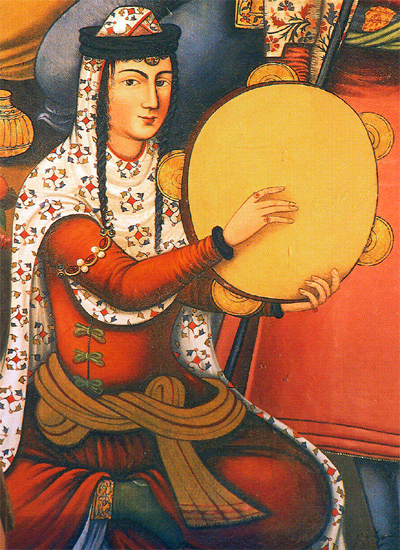|
Gayane (ballet)
''Gayane'' (''Gayaneh'' or ''Gayne'', the ''e'' is pronounced; hy, Գայանե; russian: Гаянэ) is a four-act ballet with music by Aram Khachaturian. Originally composed in or before 1939, when it was first produced (in Yerevan) as ''Happiness''. Revised in 1941–42 to a libretto by Konstantin Derzhavin and with choreography by Nina Aleksandrovna Anisimova (Derzhavin's wife), the score was revised in 1952 and in 1957, with a new plot. The stage design was by Nathan Altman (scenery) and Tatyana Bruni (costumes). The first performance took place on 9 December 1942, staged by the Kirov Ballet while in Perm, Russia, during the Second World War evacuation, and was broadcast on the radio. The principal dancers were: Natalia Dudinskaya (Gayane), Nikolai Zubkovsky (Karen), Konstantin Sergeyev (Armen), Tatanya Vecheslova (Nune), and Boris Shavrov (Giko). The conductor was Pavel Feldt. The most famous parts of the ballet are the " Sabre Dance", which has been performed ... [...More Info...] [...Related Items...] OR: [Wikipedia] [Google] [Baidu] |
Nina Aleksandrovna Anisimova
Nina Aleksandrovna Anisimova (Russian: Нина Александровна Анисимова; born St. Petersburg, 27 January 1909, died Leningrad, 23 September 1979) was a Soviet dancer and choreographer. She studied at the Petrograd (later Leningrad) Ballet School with Maria Fedorovna Romanova, Alexander Shiryaev, and Agrippina Vaganova. In 1926 she graduated from the Maly Theatre of Opera and Ballet, then from 1927 to 1958 danced with GATOB (later Kirov Ballet). In 1932 she created the role of Thérèse in Vasili Vainonen's ''Flames of Paris'', demonstrating her abilities as a character dancer. In 1936 she choreographed her first major ballet, ''Andalusian Wedding'' (music by Emmanuel Chabrier) for the Leningrad Ballet School. Her subsequent works include '' Gayane'' (music by Aram Khachaturian, 1942) for the Kirov, Perm in which she danced the lead in the " Sabre Dance".Roslavleva, p. 225. She also choreographed ''Songs of the Crane'' (music by Stepanov and Ismagilov, 1 ... [...More Info...] [...Related Items...] OR: [Wikipedia] [Google] [Baidu] |
Pavel Feldt
Pavel Emilyevich Feldt (russian: Павел Эмильевич Фельдт; 1905–1960) was a Soviet conductor and composer. Working for the Kirov Theater he conducted several ballet premieres including Shostakovich's ''The Limpid Stream'' and Khachaturian's '' Gayane''. He studied at the Petrograd-Leningrad Conservatory where Shostakovich was a fellow student. He became a ballet conductor at MALEGOT and later at the Kirov Theater in Leningrad. He conducted the premiere of ''The Limpid Stream'' in 1935. In 1942, while the company was evacuated in Perm following the German invasion of Russia, he conducted the premiere of Khachaturian's ''Gayane''. He also conducted the first production of Khachaturian's ballet, ''Spartacus Spartacus ( el, Σπάρτακος '; la, Spartacus; c. 103–71 BC) was a Thracian gladiator who, along with Crixus, Gannicus, Castus, and Oenomaus, was one of the escaped slave leaders in the Third Servile War, a major slave uprisin ...'', in 195 ... [...More Info...] [...Related Items...] OR: [Wikipedia] [Google] [Baidu] |
Kolkhoz
A kolkhoz ( rus, колхо́з, a=ru-kolkhoz.ogg, p=kɐlˈxos) was a form of collective farm in the Soviet Union. Kolkhozes existed along with state farms or sovkhoz., a contraction of советское хозяйство, soviet ownership or state ownership, sovetskoye khozaystvo. Russian plural: ''sovkhozy''; anglicized plural: ''sovkhozes''. These were the two components of the socialized farm sector that began to emerge in Soviet agriculture after the October Revolution of 1917, as an antithesis both to the feudal structure of impoverished serfdom and aristocratic landlords and to individual or family farming. The 1920s were characterized by spontaneous emergence of collective farms, under influence of traveling propaganda workers. Initially, a collective farm resembled an updated version of the traditional Russian " commune", the generic "farming association" (''zemledel’cheskaya artel’''), the Association for Joint Cultivation of Land (TOZ), and finally the ko ... [...More Info...] [...Related Items...] OR: [Wikipedia] [Google] [Baidu] |
Armenia
Armenia (), , group=pron officially the Republic of Armenia,, is a landlocked country in the Armenian Highlands of Western Asia.The UNbr>classification of world regions places Armenia in Western Asia; the CIA World Factbook , , and ''Oxford Reference Online'' also place Armenia in Asia. It is a part of the Caucasus region; and is bordered by Turkey to the west, Georgia to the north, the Lachin corridor (under a Russian peacekeeping force) and Azerbaijan to the east, and Iran and the Azerbaijani exclave of Nakhchivan to the south. Yerevan is the capital, largest city and the financial center. Armenia is a unitary, multi-party, democratic nation-state with an ancient cultural heritage. The first Armenian state of Urartu was established in 860 BC, and by the 6th century BC it was replaced by the Satrapy of Armenia. The Kingdom of Armenia reached its height under Tigranes the Great in the 1st century BC and in the year 301 became the first state in the worl ... [...More Info...] [...Related Items...] OR: [Wikipedia] [Google] [Baidu] |
Glockenspiel
The glockenspiel ( or , : bells and : set) or bells is a percussion instrument consisting of pitched aluminum or steel bars arranged in a keyboard layout. This makes the glockenspiel a type of metallophone, similar to the vibraphone. The glockenspiel is played by striking the bars with mallets, often made of a hard material such as metal or plastic. Its clear, high-pitched tone is often heard in orchestras, wind ensembles, marching bands, and in popular music. Terminology In German, a carillon is also called a , and in French, the glockenspiel is sometimes called a . It may also be called a () in French, although this term may sometimes be specifically reserved for the keyboard glockenspiel. In Italian, the term () is used. The glockenspiel is sometimes erroneously referred to as a xylophone. The Pixiphone, a type of toy glockenspiel, was one such instrument sold as a xylophone. Range The glockenspiel is limited to the upper register and usually covers about ... [...More Info...] [...Related Items...] OR: [Wikipedia] [Google] [Baidu] |
Dayereh
Daf ( fa, دف) also known as Dâyere and Riq is a Middle Eastern (mainly Iranian) frame drum musical instrument, used in popular and classical music in South and Central Asia. It is also used in Afghanistan, Azerbaijan, Tajikistan, Iran, Uzbekistan, many regions of Georgia, Pakistan as well as in parts of India and Russian polar regions. It is also popular among Balkans, Bukharan Jews, Caucasians, Kurds, and Macedonians. Daf is the national musical instrument of Pakistan and is also depicted on the reverse and obverse of the Azerbaijani 1 qəpik coin and 1 manat banknote respectively, since 2006. It traditionally has a round wooden frame (although in the modern era it may also be made of metal), jingles, and a thin, translucent head made of fish or goat skin (or, more recently, a synthetic material). The sound is produced by hitting the membrane with either hand – the left hand, which also holds the Daf, strikes the edges, and the right hand strikes the center. The ... [...More Info...] [...Related Items...] OR: [Wikipedia] [Google] [Baidu] |
Nagara (drum)
The ''nagara'' or ''naghara'' is a drum used in the Middle East. There are several types of naghara, which is considered to be the lead instrument in folk ceremonies and weddings. The naghara differs in size and goes by various names such as " boyuk nagara" (big naghara), " cura nagara" (small naghara), "chiling naghara" (played with drum sticks), " Qoltuq nagara" (drum held under the arm), gosha naghara (Naqareh) and "el naghara" (hand naghara). Nagada (Indian Drum) is a percussion instrument used for its rhythmic sounds.. Nakara is a festival instrument mostly used in South Indian Hindu temples. The size may vary and this instrument may be kept near the entrance of the South Indian Hindu temples. Temple musical instrument Nagada is played even now in chosen Hindu temples in Tamil Nadu. The temple musical instruments are termed as Kethu or jalliry or jalli instruments (Tamil Language: கெத்து வாத்தியம், "ஜல்லிரி', "ஜல்லி ... [...More Info...] [...Related Items...] OR: [Wikipedia] [Google] [Baidu] |
Armenians
Armenians ( hy, հայեր, '' hayer'' ) are an ethnic group native to the Armenian highlands of Western Asia. Armenians constitute the main population of Armenia and the ''de facto'' independent Artsakh. There is a wide-ranging diaspora of around five million people of full or partial Armenian ancestry living outside modern Armenia. The largest Armenian populations today exist in Russia, the United States, France, Georgia, Iran, Germany, Ukraine, Lebanon, Brazil, and Syria. With the exceptions of Iran and the former Soviet states, the present-day Armenian diaspora was formed mainly as a result of the Armenian genocide.Richard G. Hovannisian, ''The Armenian people from ancient to modern times: the fifteenth century to the twentieth century'', Volume 2, p. 421, Palgrave Macmillan, 1997. Armenian is an Indo-European language. It has two mutually intelligible spoken and written forms: Eastern Armenian, today spoken mainly in Armenia, Artsakh, Iran, and the former ... [...More Info...] [...Related Items...] OR: [Wikipedia] [Google] [Baidu] |
Aliens (film)
''Aliens'' is a 1986 science fiction action film written and directed by James Cameron. It is the sequel to the 1979 science fiction horror film '' Alien'', and the second film in the ''Alien'' franchise. The film is set in the far future; Sigourney Weaver stars as Ellen Ripley, the sole survivor of an alien attack on her ship. When communications are lost with a human colony on the moon where her crew first saw the alien creatures, Ripley agrees to return to the site with a unit of Colonial Marines to investigate. Michael Biehn, Paul Reiser, Lance Henriksen, and Carrie Henn feature in supporting roles. Despite the success of ''Alien'', its sequel took years to develop due to lawsuits, a lack of enthusiasm from 20th Century Fox, and repeated changes in management. Although relatively inexperienced, Cameron was hired to write a story for ''Aliens'' in 1983 on the strength of his scripts for '' The Terminator'' (1984) and '' Rambo: First Blood Part II'' (1985). The projec ... [...More Info...] [...Related Items...] OR: [Wikipedia] [Google] [Baidu] |
James Cameron
James Francis Cameron (born August 16, 1954) is a Canadian filmmaker. A major figure in the post- New Hollywood era, he is considered one of the industry's most innovative filmmakers, regularly pushing the boundaries of cinematic capability with his use of novel technologies. He first gained recognition for writing and directing '' The Terminator'' (1984) and found further success with ''Aliens'' (1986), '' The Abyss'' (1989), '' Terminator 2: Judgment Day'' (1991), and the action comedy '' True Lies'' (1994). He wrote and directed '' Titanic'' (1997) and ''Avatar'' (2009), with ''Titanic'' earning him Academy Awards for Best Picture, Best Director and Best Film Editing. A recipient of various other industry accolades, two of his films have been selected for preservation in the National Film Registry by the Library of Congress. Cameron co-founded the production companies Lightstorm Entertainment, Digital Domain, and Earthship Productions. In addition to filmmaking, he ... [...More Info...] [...Related Items...] OR: [Wikipedia] [Google] [Baidu] |
James Horner
James Roy Horner (August 14, 1953 – June 22, 2015) was an American composer. He was known for the integration of choral and electronic elements, and for his frequent use of motifs associated with Celtic music. Horner's first film score was in 1979 for '' The Lady in Red'', but he did not establish himself as an eminent film composer until his work on the 1982 film '' Star Trek II: The Wrath of Khan''. His score for James Cameron's '' Titanic'' is the best-selling orchestral film soundtrack of all time. He also wrote the score for the highest-grossing film of all time, Cameron's '' Avatar''. Horner also scored other notable films including '' Star Trek III: The Search for Spock'' (1984), '' The Name of the Rose'' (1986), ''Aliens'' (1986), Willow (1988), '' Field of Dreams'' (1989), '' Honey, I Shrunk the Kids'' (1989), '' The Rocketeer'' (1991), '' Braveheart'' (1995), '' The Mask of Zorro'' (1998), '' Deep Impact'' (1998), '' A Beautiful Mind'' (2001) and '' The Amazing Sp ... [...More Info...] [...Related Items...] OR: [Wikipedia] [Google] [Baidu] |



